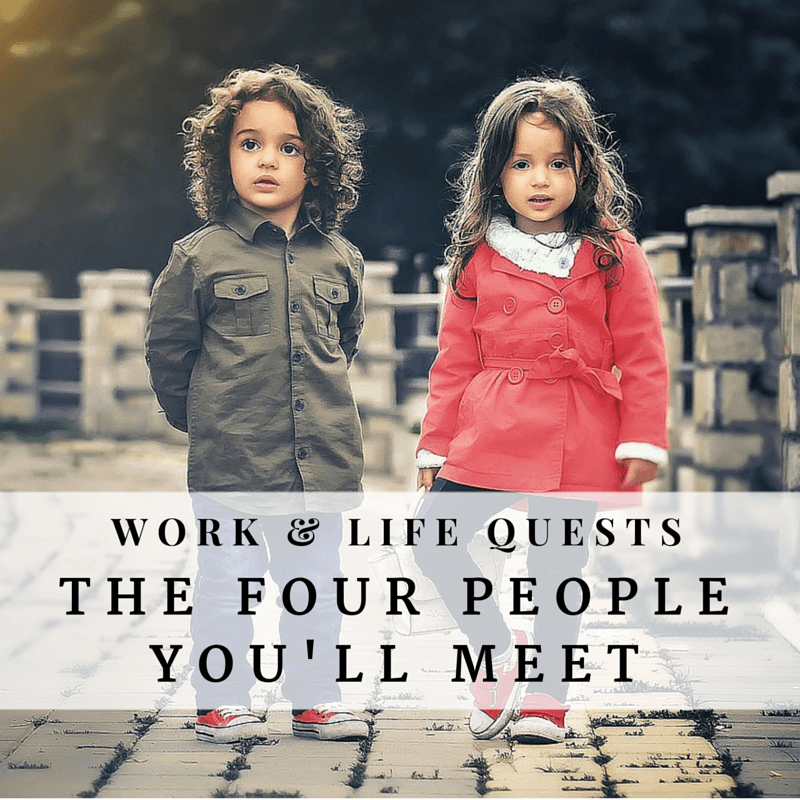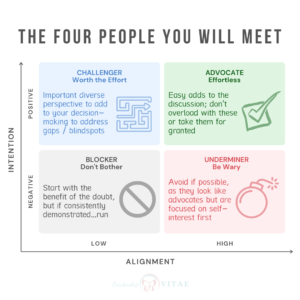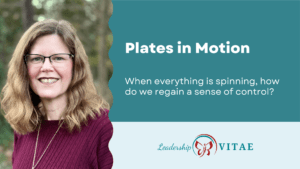
Recently, our organization brought someone new on board. In our first meeting, I felt an immediate kinship with him. Though we just met, each time we talk, it’s like we’ve known each other for years. Sometimes it’s like that – an effortless connection or affinity with someone new.
When he asked me for insight to the politics and people of the organization, I was happy to oblige. But first, I had to explain to him the way I “see” people.
I evaluate two things – intent and alignment – when I want to engage, pitch, and otherwise work with others. When evaluating intent, the question I try to answer is “does the person mean well?” For alignment, it’s “are we coming at this [issue/opportunity] from the same perspective?”
In my younger years, I only considered intent. As I got older, I realized that too often I mistook a lack of alignment with poor intent. Now, I try to start from an assumption that people mean well, but we may have a different point of reference. Instead of seeing those differences as merely a frustration, now I realize they may be a very good thing indeed.
By considering someone’s intent and alignment, I can determine which of four different “types” an individual is likely to be.
Type 1 – Advocates (Effortless)
Individuals that come from a place of good intentions and are aligned to your way of thinking are a joy to work and interact with. They are some of the easiest to recognize and welcome into your life. With Advocates, you can discuss any topic – including the ones that are usually off-limits – and walk away friends regardless of what side of the argument you were on. Your natural affinity allows you to challenge and argue, ultimately coming to a common understanding or solution with little headache.
As you journey through life and work, maintaining connections with Advocates is critical. Don’t take them for granted, even though your affinity and like-mindedness means you could probably go years and then pick up the phone as if you talked yesterday. They are rare and valuable enough to make an effort, even when the relationship feels effortless.
Type 2 – Challengers (Worth the Effort)
Some of the most important, yet often frustrating, individuals in our universe are the Challengers. These are the folks that have good intentions, but they just don’t come at things the same way we do. It would be easy to dismiss them as being Blockers and walk away, but that would be a tragedy to anyone looking for successful outcomes.
It has been proven that diverse teams are more successful than homogeneous ones. A bunch of Advocates would probably come to agreement on an issue faster and easier than any other group, even if they didn’t originally agree. However, by adding Challengers to the mix, the diverse perspectives they bring to the table can help address gaps or reveal considerations the rest of the group would be blind to.
By actively looking for individuals that have good intent, but are not like-minded, we can achieve true breakthroughs and innovation. This is a critical group to engage for well-rounded solutions. And a well-rounded life. Keep in mind that, from their perspective, YOU’RE the Challenger!
Type 3 – Underminers (Be Wary)
Underminers are probably the most concerning group of the four. They can have all the characteristics of an Advocate, but ultimately, they are not interested in much more than themselves. They will align themselves with the solutions, projects and ideas that have leadership support and say all the right things. When it comes to actually getting things done, however, don’t expect much. And if something looks like it might go wrong, they’ll be the first ones to bail out, leaving you holding the bag.
Give people the benefit of the doubt and start from the assumption that if you are aligned, the individual is likely also coming from a good place and will be an Advocate. However, don’t ignore the warning signs. If you start to get the sense that your values are not aligned, and this person might be an Underminer, watch your back. Underminers are usually politically savvy and put on a good show that might fool senior leaders. Outright conflict is best avoided. Instead, begin to distance yourself as much as possible, and if all else fails, document, document, document.
Type 4 – Blockers (Don’t Bother)
I’m naive enough to believe that everyone starts out wanting provide a positive contribution and do the right thing. I’m also realistic enough to recognize that some folks take the easy road. The road that means openly putting their own interests first, moving up at the expense of others. That will leave ethics at the door if they are inconvenient or stand in the way of getting ahead.
Luckily, these individuals are becoming more and more rare. Those that come from an obvious place of bad intention, with values that are out of whack, can do a lot of damage to an organization. In today’s environment, not only are these individuals being purged, sometimes their departure from an organization includes stiff penalties and jail time. Just look at the Enron executives who put themselves ahead of their people.
Before assuming someone is a Blocker, stop to think if they are generally trying to do the right thing. They could very well be a Challenger that you simply cannot come to agreement with. That’s okay. If, however, you find that this individual is a Blocker, run, do not walk to the nearest exit.
My Findings
In the last two decades, I have found that the majority of people I meet and work with mean well, though most of them do not approach problems and opportunities with the same mindset I do. I do my best to embrace their perspectives, even when their points of view might push my buttons. Though rarer to find, I also keep my eyes open to those that are purely motivated by self-interest, whether obvious about it or not.
It was with joy that I shared my perspectives with our organization’s newest member. So far, it seems like everyone has good intentions, with the best interests of our customers at heart. Do we consistently agree? Absolutely not. We have too much diversity of thought and experience to make any discussion an easy one. However, the combination is critical to achieving the bold objectives we’re pursuing. I look forward to all of us making the – likely eventful – journey together.
I’d be interested in your feedback. Do you find that most people have good intentions and mean well? Do you look for individuals that align with your thought processes, or intentionally seek out those that challenge you to think differently? I’d love for you to share your comments below.










10 Responses
Is this your own creation? If so, I think you’ve pretty much nailed it; especially the cautionary note that from a Challenger’s perspective YOU are the Challenger. So often models like this only consider the perspective of the person utilising the model so it was refreshing to see that mentioned in there.
As always, I loved reading it,
Chris
Chris,
Thank you for the feedback! It is my own perspective/thought process, honed to the point of being a “model” by sharing it many times over the years, particularly in the last few months. When I hear frustration with a colleague from my peers and team members, I start by asking “Do you think he/she is trying to do the right thing? Do you think he/she means well?” The moment of hesitation – stopping to consider where the other person is coming from – is often enough to take the emotion right out of it and bring the focus back to the topic at hand.
You are right that we rarely hear about what others may be perceiving when we are taught how to evaluate a situation or individual. That was a late add that I felt hinted at the idea of OTHERS seeing us as challenging, when we mean well and want to do the right thing. How could they?!?! Your comment affirms the decision to add it.
I very much appreciate that you took the time to read the article and comment back. Thanks again!
Kristin
Kristin,
I have to agree with Chris, you have really nailed this very succinctly. It is incredibly thought provoking and giving me a new way to look at my work relationships.
As managers we get protective of our teams and our area’s of influence. I believe a good manager’s intent is three fold: 1st doing what is right for the company and 2d what is right for the customer and 3d what is right for the team. The hard part is realizing that the 3d one seems to be the one we fail at because the first two take priority. While taking care of these three we can become blockers or underminers before we know it.
Thanks for your thought provoking posts!
Kevin
Kevin,
Thank you so much for taking the time to read the article and provide your feedback. It’s great to know that it resonated.
I agree that it can be challenging to balance the needs of everyone “pulling” at us as leaders/managers. What I’d offer is to flip the priorities around. Focus on people first, then customers and then the company. People take care of customers and deliver for the company. If they are the focus, they get you the other two with what seems like little effort. I agree that the formula you laid out can result in leaders becoming something other than they intend, so let’s switch it up!
Thanks again for reading!
Kristin
Like the way that you outlined this. Very helpful to keep these types in mind when meeting people and learning/integrating new team members.
Thank you, Ed! If you end up putting the model into practice, I’d love to hear how it worked for you or the circumstances where you found it the most valuable.
I totally agree that this can be used with new teams and team members. My team is brand new, so we’re all getting to know each other. Two of us have been struggling to find common ground, so I pulled this out as a way to explain that we both have good intentions, but are coming at the problem from different perspectives. By the end of the discussion, we were each able to share what we were hearing vs what the other was saying. We were so much closer than we thought! By remembering that we both mean well, it helped work through the language barrier and frustration to come to a mutual understanding.
Thanks again for reading and the feedback!
Kristin
Kristin –
Tonight I bumped into you on LikedIn, and came across your blog. I must say I am incredibly impressed. In my years at my current organization, I have tried hard to understand what seems to be a perplexing and conflicting culture. Once I read your blog, it all made perfect sense. As you said the Advocates are really easy to see and can be maintained with little effort. What I found insightful is the distinction between the Challengers and the Underminers. I have had these two completely reversed! IT’s easy to see in hindsight, but then it’s too late. Being able to correctly recognize and manage these four types on a regular basis is the secret sauce. Looking forward to exploring more of your blog.
Tim,
Great to hear from you! I hope things are going well upon your return from the Summit and your team is still making progress on their transformation.
I used to see things as pretty black and white – basically advocates and blockers. I added challengers when I started working on organizational change and realized that a lot of the groups being impacted had customer focus and other characteristics I generally find in advocates. I had to be willing to put my own perspective aside to see theirs and found better solutions as a result. The underminders were a very recent add. People I trusted had a very different perspective of an individual I genuinely liked and considered an advocate. I had to start with the benefit of the doubt, to remain true to my nature, but quickly figured it out. If you have trusted, long-term relationships with people that have similar values as you – listen to them. They could mistake a challenger for a blocker, potentially, but if you see someone as an advocate that they see in a very different light, it pays to listen.
Glad to know this helped and I look forward to your continued exploration of the site! I’d appreciate feedback on what’s here already, ideas/suggestions of topics you’d like to see that I haven’t written about yet, or whatever else you have the time to share.
Thanks again!
Kristin